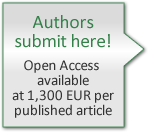Articles
All articles | Recent articles
Future Research in Refractories: A Roadmap Approach
A. Geigenmüller1, H. Spindler1, K. Lenk1, C. G. Aneziris2
1 Technische Universität Ilmenau, Faculty of Economic Sciences and Media, Department of Marketing, Helmholtzplatz 3, 98693 Ilmenau, Germany
2 Technische Universität Bergakademie Freiberg, Institute of Ceramics, Glass and Construction Materials, Agricolastrasse 17, 09599 Freiberg, Germany
received October 20, 2013, received in revised form October 21, 2013, accepted December 10, 2013
Vol. 5, No. 2, Pages 71-76 DOI: 10.4416/JCST2013-00032
Abstract
Science and technology roadmaps are valuable instruments for strategic planning in research. Especially for interdisciplinary fields such as materials science and technology, roadmaps are promising instruments for identifying relevant research themes and interfaces between different disciplines and actors. Against this background, this paper aims at developing a roadmap for refractory research in order to strategically promote the field, to initiate ground-breaking research endeavors and valuable collaborations and to advance fundamental and applied refractory research. To this end, the study employs an extensive review of existing roadmaps, strategic papers, reports, and presentations in the fields of materials science and engineering, ceramics, glass, metals, metallurgy, and refractory applications. Furthermore, in-depth interviews with national and international experts from academia, industry and professional associations provide judgments about future research trends and estimates about their time of occurrence. The study identifies four main future research areas, including novel materials compositions as enablers for improved or extended materials properties, new approaches for materials preparation, forming and processing technologies. Moreover, modeling and forecasting of materials properties and performance are identified as important fields for future research.
![]() Download Full Article (PDF)
Download Full Article (PDF)
Keywords
Roadmap, strategic planning, refractories, materials synthesis, preparation, processing, testing, modeling and simulation
References
1 Headrick, W.L.: Toward a "greener" future with advanced refractories, Am. Ceram. Soc. Bull., 92, 28 – 31, (2013).
2 Hemrick, J.G.: Improved refractories = energy saving, Am. Ceram. Soc. Bull., 92, 32 – 35, (2013).
3 Aldinger, J., Baumard, J.F.: Advanced ceramic materials: basic research viewpoint. European Whitebook on Fundamental Research in Materials Science. Max Planck Institute for Materials Research, Stuttgart, 26 – 31, (2001).
4 Taylor, J.: Managing the unmanageable: the management of research in research-intensive universities, Higher Education Management and Policy, 18, 9 – 33, (2006).
5 Kostoff, R.N., Schaller, R.R.: Science and technology roadmaps, IEEE Trans. Eng. Manage., 48, 132 – 143, (2001).
6 Probert, D.R., Farrukh, C.J.P., Phaal, R.: Technology roadmapping – developing practical approach for linking resources to strategic goals, Proc. Insta Mech. Engrs. Vol. 217, Part B: J. Engineering Manufacture, 1183 – 1195, (2003).
7 Kappel, T.A.: Perspectives on roadmaps: How organizations talk about the future, J. Prod. Innovat. Manage., 18, 39 – 50, (2001).
8 Guimaraes, T.A., Borges-Andrade, J.E., dos Santos Machado, M., Vargas, M.R.M.: Forecasting core competencies in R&D environment, R&D Manage., 31, 249 – 255, (2001).
9 Gerdsri, N.: An analytical approach to building a technology development envelope (TDE) for roadmapping of emerging technologies, Intern. J. of Innovation and Technology 4, 121 – 135, (2007).
10 Roedel, J., Kounga, A.B.N., Weissenberger-Eibl, M., Koch, D., Bierwisch, A., Rossner, W., Hoffmann, M.J., Danzer, R., Schneider, G.: Development of a roadmap for advanced ceramics, J. Eur. Ceram. Soc., 29, 1549 – 1560, (2001).
11 Strauss, J.D., Radnor, M.: Roadmapping for dynamic and uncertain environments, Res. Technol. Manage., March/April, 51 – 57, (2004).
12 Möhrle, M.G: Forms of research-related roadmaps of technology (in German). In: Technology-roadmapping. Future strategies for technology companies. (in German). Möhrle, M. G., Isenmann, R. (Ed.), 1 – 15, Wiesbaden, (2008).
13 Kostoff, R.N., Boylan, R., Simons, G.R.: Disruptive technology roadmaps, Technol. Forecast. Soc., 71, 141 – 159, (2004).
14 Probert, D., Shehabuddeen, N.: Technology road mapping: the issues of managing technology change, Int. J. Technol. 17, 646 – 661, (1999).
15 Hattendorf Westney, L.C.: Historical rankings of science and technology: A citationist perspective, J. Association for History and Computing, 1, (1998).
16 Brown, L.D., Gardner, J.C.: Using citation analysis to assess the impact of journals and articles on contemporary accounting research (CAR), J. Account. Res., 23, 84 – 109, (1985).
17 Garfield, E.: Citation indexing: Its theory and application in science, technology and humanities, New York, NY: Wiley, (1979).
18 Norris, M., Oppenheim, C.: Citation counts and the research assessment exercise: V. Archeology and the 2001 RAE, J. Doc., 59, 709 – 730, (2003).
19 Deenen, M.A., Gross, A.C.: Refractory Materials: The global market, the global industry, Business Econ., 45, 288 – 295, (2010).
Copyright
Göller Verlag GmbH


